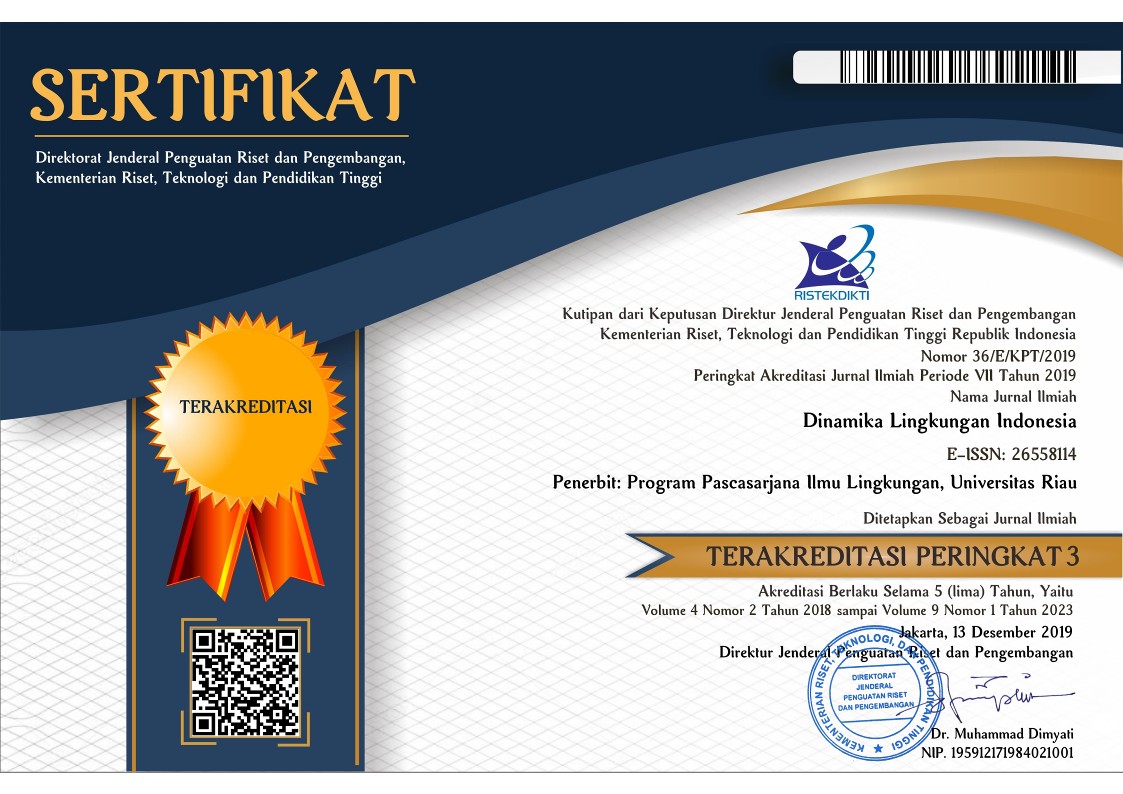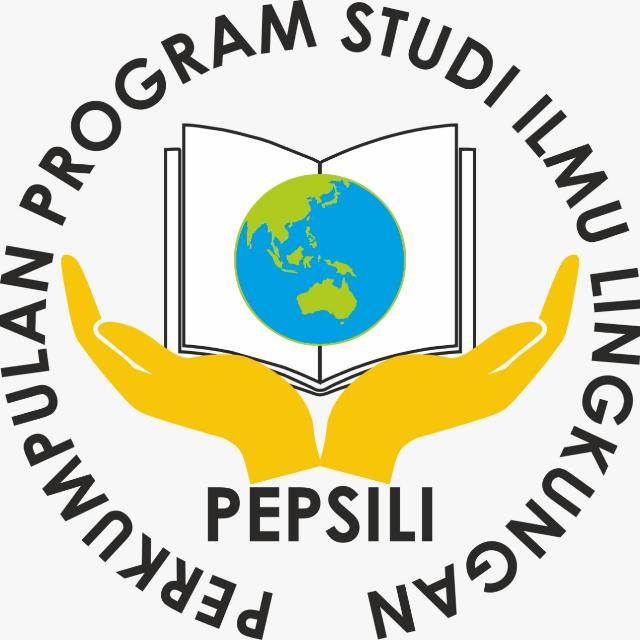Faktor lingkungan yang mempengaruhi keberadaan hama yang mengganggu penghuni rumah di Kota Pekanbaru
Abstract
Pests that are often a household problem in several cities in Indonesia are mosquitoes, rats, cockroaches, flies. Causes of settlement pests are dirty environments, food scraps, rubbish, and waterlogged gutters / ditches. The presence of pests in the house causes occupants to control pesticides. Pesticides are used primarily to control mosquitoes, ants, flies, cockroaches, mice and termites. This research is a descriptive research that aims to explain, detail and make a description of a phenomenon or object under study. The target population in this study is households residing in Pekanbaru City, namely in the Districts of Tenayan Raya, Sail and Pekanbaru City with three clean, medium and dirty categories. Determination of the sample is done purposively with multistage sampling technique. The sample was determined purposively with multistage sampling technique and the total sample was 101 households. The data obtained were nominal, ordinal and ratio, analyzed the relationship between these data using chi-square. The results showed that the physical environmental factors of housing settlements that affect the presence of residential pests are dirty environments caused by garbage and dirty drainage / ditches. Meanwhile, biotic environmental factors in residential housing that affect the presence of pests are plants grown in residential areas in the form of ornamental plants and unkempt shade plants. The dirty condition of the residential environment is due to the lack of environmental cleaning activities and the not yet routine transportation of waste from residential homes to landfills. In addition, there is less care for ornamental plants and shade in the yard, such as pruning.
Keywords
Full Text:
PDFReferences
Arroyo, H.S., & Capinera, J.L. (2008). House Fly Musca domestica Linnaeus (Insecta: Diptera: Muscidae). EENY-48, University of Florida. http://entnemdept.ufl.edu/creatures/urban/flies/house_fly.HTM. Diakses 26 Nopember 2016.
BAPPEDA (Badan Perencanaan Pembangunan Daerah) Kota Pekanbaru. (2015). Informasi Kota Pekanbaru tahun 2015. Badan Perencanaan Pembangunan Daerah (BAPPEDA) Kota Pekanbaru, Pekanbaru.
Bell, W.J., Louis, M.R., & Nalepa, C.A. (2007). Cockroaches: Ecology, Behavior, and Natural History. Johns Hopkins University Press, Baltimore.
Buczkowski, G. (2014). Urban pest management: The need for a correct mixture of knowledge and practice. In Urban Insect Pests-Sustainable Management Strategies, ist ed.; Dhang, P. (Ed.). CAB International: Oxfordshire, UK.
Dingha, B., Jackai, L., Monteverdi, R.H., & Ibrahim, J. (2013). Pest control practices for the German Cockroach (Blattodea: Blattellidae): a survey of rural residents in North Carolina. Florida Entomologist. 96(3):1009-1015.
Farooq, U., Joshi, M., Nookala, V., Cheriyath, P., Fischman, D., Graber, N. J., Stellman, S. D., & Muscat, J. (2010). Self-reported exposure to pesticides in residential settings and risk of breast cancer: a case-control study. Environ-mental Health. 9(30): 1-9.
Gomez, M. D., Cecilia, P. M.,& Polop, J. J. (2008). Effect of interspecific compe-tition on Mus musculus in an urban area. Journal of Pest Science. 81 (4): 235-240.
Grossman, J. (1995). What’s hiding under the sink: dangers of household pesticides. Environ Health Perspect. 103(6):550–4.
Guha, N., Ward , M. H., Gunier, R., Colt, J. S., Lea, C. S., Buffler, P. A., & Metayer, C. (2013). Characterization of residential pesticide use and chemical formulations through self-report and household inventory: the Northern California childhood leukemia study. Environmental Health Perspectives. 121(2):276-282.
Himsworth, C.G., Feng, A. Y. T., Parsons, K., Kerr, T., & Patrick, D. M. (2013). Using experiential knowledge to understand urban rat ecology: A survey of Canadian pest control professionals. Urban Ecosyst. 16:341–350.
Kardinan, A. (2007). Potensi selasih sebagai repellent terhadap nyamuk Aedes aegypti. Jurnal Penelitian Tanaman Industri. 13(2): 39-42.
_______. (2005). Daya proteksi zodia terhadap nyamuk Aedes aegypti. Jurnal Ilmiah Pertanian Gakuryoku. 11(1): 49-53.
_______. (2000). Pestisida Nabati, Ramuan dan Aplikasi. Cetakan ke-2. Penebar Swadaya, Jakarta.
Kass, D.E., McKelvey, W., Wye, G. V., Kerker, B., Mostashari, F., & Eisenhower, D. (2005). Pests Can be Controlled Safely. NYC Vital Signs. 4(3):1–4.
Koehler, P.G. (2013). Urban Pests and Pest Management. This document is SP486A (IN1073), one of a series of the Entomology and Nematology Department, UF/IFAS Extension at http://edis.ifas.ufl.edu. The Institute of Food and Agricultural Sciences (IFAS).
Laksham K. B., Vinothkumar, K., Parthibane, S., Murthy, S. P., Arunachalam M. K., & Chinnakali, P. (2016). Household biocide use and personal safety practices among rural population in South India: a community-based study. Česká a Slovenská Neurologie a Neurochirurgie. 79 (1):599-604.
Mavi, H.S., & Tupper, G. J. (2004). Agrometeorology: Principles and Applications of Climate Studies in Agriculture. Food Products Press, New York.
Nafis, F. (2009). Persepsi masyarakat perkotaan terhadap hama permukiman serta pengujian perangkap dan pestisida untuk mengendalikan tikus dan kecoa. Thesis. Sekolah Pascasarjana Institut Pertanian Bogor, Bogor.
Oka, I.N. (2005). Pengendalian hama terpadu dan implementasinya di Indonesia. Gadjah Mada University Press. Yogyakarta.
Raini, M. (2009). Toksikologi Insektisida Rumah Tangga dan Pencegahan Keracunan. Media Penelit. dan Pengembang. Kesehat. 14(Suplemen II). Balitbang Departemen Kesehatan RI, Jakarta.
Samways, M.J. (1996). Insects in the Urban Environment: Pest Pressures Versus Conservation Concern. In Wildey, K.B. (editor). Proceedings of the Second International Conference on Urban Pests.
Scott, J. G., Warren, W. C., Beukeboom, L. W., Bopp, D., Clark, A. G., Giers, S. D., Hediger, M., Jones, A. K., Kasai, S., Leichter, C. A., Li, M., Meisel, R. P., Minx, P., Murphy, T. D., Nelson, D. R., Reid, W. R., Rinkevich, F. D., Robertson, H. M., Sackton, T. B., Sattelle, D. B., Thibaud-Nissen, F., Tomlinson, C., van de Zande, L., Walden, K. K., Wilson, R. K., & Liu, N. (2014). Genome of the house fly, Musca domestica L., a global vector of diseases with adaptations to a septic environment. Genome Biol.15(10): 466;1-16.
Singarimbun, M., dan Effendi. (2006). Metode Penelitian Survey. LP3ES, Jakarta.
Sigit, H.S., Koesharto, F. X., Hadi, U. K., Gunandini, D. J., dan Soviana, S. (2006). Hama Pemukiman Indonesia, Penge-nalan, Biologi dan Pengendalian. Unit Kajian Pengendalian Hama Permu-kiman (UKPHP), Fakultas Kedokteran Hewan IPB. Bogor.
Speight, M.R., Hunter, M. D., & Watt, A. D. (2008). Ecology of Insects: Consepts and Application. The Alden Press, Britain.
Sutikno, A., Saputra, R., Rasyad, A., Amin, B., & Mahatma, R. (2020). The Behavior of People at Pekanbaru City Indonesia in the Use of Household Pesticides to Control Pest of Settlement. J. Phys.: Conf. Ser. 1655 012101. DOI:10.1088/1742-6596/1655/1/012101
Sutikno, A., Rasyad, A., Amin, A., & Mahatma, R. (2020). Persepsi Masyarakat Kota Pekanbaru Tehadap Gangguan Hama Permukiman. JIP. 16(28):1-9.
_______. (2019a). Use of pesticides for household pest control in Pekanbaru City . Poll Res. 38 (4): 885-889.
_______. (2019b). The Perception of the Pekanbaru City resident on household pesticides. J. Phys.: Conf. Ser. 1351 012106. DOI:10.1088/1742-6596/1351/1/012106.
Untung (2006) & Oka (2005) WHO (World Health Organization). (1999). Safe and effective use of household insecticide products. Geneva: World Health Organization. New York.
Yuliani, T. S. (2012). Perilaku penggunaan pestisida oleh ibu rumah tangga di wilayah DKI Jakarta. Disertasi. Sekolah Pasca-sarjana Instititut Pertanian Bogot, Bogor.
DOI: http://dx.doi.org/10.31258/dli.8.1.p.65-72
Refbacks
- There are currently no refbacks.





